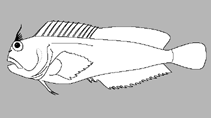http://www.fishbase.org/Summary/speciesSummary.php?genusname=Praealticus&speciesname=oortii ---> http://52.67.158.155/Summary/speciesSummary.php?genusname=Praealticus&speciesname=oortii
http://52.67.158.155/Summary/speciesSummary.php?genusname=Praealticus&speciesname=oortii ---> https://fishbase.net.br/Summary/speciesSummary.php?genusname=Praealticus&speciesname=oortii
https://fishbase.net.br/Summary/speciesSummary.php?genusname=Praealticus&speciesname=oortii ---> https://fishbase.net.br/summary/Praealticus-oortii.html
Praealticus oortii, Java rockskipper

You can
sponsor
this page
Common name (e.g. trout)
Genus + Species (e.g. Gadus morhua)
-

-
About this page
-
Languages
-
User feedbacks
-
Citation
-
Uploads
-
Related species
-


 Java rockskipper
Add your observation in
Fish Watcher
Upload your
photos
and
videos
Java rockskipper
Add your observation in
Fish Watcher
Upload your
photos
and
videos
Google image
 No image available for this species;
No image available for this species;
drawing shows typical species in Blenniidae.
Teleostei (teleosts) >
Blenniiformes
(Blennies) >
Blenniidae
(Combtooth blennies) > Salariinae
Etymology:
Praealticus:
Latin, prae = in front of + Latin, altus, alticus = nutritious
.
More on author:
Bleeker
.
Environment: milieu / climate zone / depth range / distribution range
Ecology
Marine; demersal. Tropical
Western Central Pacific.
Size / Weight / Age
Maturity: L
m
?
range ? - ? cm
Max length : 6.0 cm TL male/unsexed; (Ref.
90102
)
Short description
Morphology
|
Morphometrics
Dorsal
spines
(total): 13;
Dorsal
soft rays
(total): 17-19;
Anal
spines
: 2;
Anal
soft rays
: 19 - 21. Color in life unknown. Preserved specimen with vertically elongate blotch behind eye; ca. 10 bifurcate bars on body and dark spots on anterior body. Dorsal fin deeply notched; segmented caudal rays typically 13-14, middle 2-8 (typically 5-8)branched; supraorbital tentacle pinnately branched; nape cirri absent; posterior rim of anterior nostril with small cirrus (typically unbranched); upper lip margin laterally crenulate; males with occipital crest; last dorsal ray and caudal peduncle connected by membrane; body elongate, depth at anal-fin origin ca. 7.0 in SL. Maximum length, 6 cm TL (Ref.
90102
).
Facultative air-breathing (Ref.
126274
); Adults inhabit rocky shores (Ref.
90102
). Oviparous. Eggs are demersal and adhesive (Ref.
205
), and are attached to the substrate via a filamentous, adhesive pad or pedestal (Ref.
94114
). Larvae are planktonic, often found in shallow, coastal waters (Ref.
94114
).
Life cycle and mating behavior
Maturity
|
Reproduction
|
Spawning
|
Eggs
|
Fecundity
|
Larvae
Oviparous, distinct pairing (Ref.
205
).
Springer, V.G.
, 2001. Blennidae. Blennies (combtooth and sabertooth blennies). p. 3538-3546. In K.E. Carpenter and V. Niem (eds.) FAO species identification guide for fishery purposes. The living marine resources of the Western Central Pacific. Vol. 6. Bony fishes part 4 (Labridae to Latimeriidae), estuarine crocodiles. FAO, Rome. (Ref.
12848
)
IUCN Red List Status (Ref.
130435
)
Least Concern (LC)
; Date assessed:
27 March 2009
CITES
Not Evaluated
Not Evaluated
Threat to humans
Harmless
Human uses
FAO - Publication:
search
|
FishSource
|
More information
Countries
FAO areas
Ecosystems
Occurrences
Introductions
Stocks
Ecology
Diet
Food items
Food consumption
Ration
Common names
Synonyms
Metabolism
Predators
Ecotoxicology
Reproduction
Maturity
Spawning
Spawning aggregation
Fecundity
Eggs
Egg development
Age/Size
Growth
Length-weight
Length-length
Length-frequencies
Morphometrics
Morphology
Larvae
Larval dynamics
Recruitment
Abundance
BRUVS
References
Aquaculture
Aquaculture profile
Strains
Genetics
Electrophoreses
Heritability
Diseases
Processing
Nutrients
Mass conversion
Collaborators
Pictures
Stamps, Coins Misc.
Sounds
Ciguatera
Speed
Swim. type
Gill area
Otoliths
Brains
Vision
Tools
E-book
|
Field guide
|
Length-frequency wizard
|
Life-history tool
|
Point map
|
Classification Tree
|
Catch-MSY
|
Special reports
Check for Aquarium maintenance
|
Check for Species Fact Sheets
|
Check for Aquaculture Fact Sheets
Download XML
Summary page
|
Point data
|
Common names
|
Photos
Internet sources
AFORO (otoliths) |
Aquatic Commons
|
BHL
|
Cloffa
|
BOLDSystems
|
Websites from users
|
Check FishWatcher
|
CISTI
|
Catalog of Fishes
:
genus
,
species
|
DiscoverLife
|
ECOTOX
| FAO - Publication:
search
|
Faunafri
| Fishipedia |
Fishtrace
| GenBank:
genome
,
nucleotide
|
GloBI
|
Google Books
|
Google Scholar
|
Google
| IGFA World Record |
MitoFish
|
Otolith Atlas of Taiwan Fishes
|
PubMed
| Reef Life Survey | Socotra Atlas |
Tree of Life
| Wikipedia:
Go
,
Search
| World Records Freshwater Fishing |
Zoological Record
Estimates based on models
Preferred temperature (Ref.
123201
): 28.3 - 29.3, mean 28.8 °C (based on 1038 cells).
Phylogenetic diversity index (Ref.
82804
): PD
50
= 0.5001 [Uniqueness, from 0.5 = low to 2.0 = high].
Bayesian length-weight: a=0.01000 (0.00244 - 0.04107), b=3.04 (2.81 - 3.27), in cm total length, based on all LWR estimates for this body shape (Ref.
93245
).
Trophic level (Ref.
69278
): 2.0 ±0.00 se; based on food items.
Resilience (Ref.
120179
): High, minimum population doubling time less than 15 months (Preliminary K or Fecundity.).
Fishing Vulnerability (Ref.
59153
): Low vulnerability (10 of 100).
Back to Search
Random Species
Back to Top
Accessed through:
Not available
FishBase mirror site :
Laguna, Philippines
Page last modified by :
mrius-barile
|